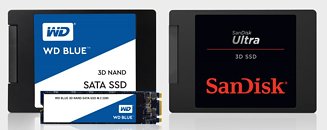Friday, July 28th 2017

Western Digital, SanDisk Shipping 3D NAND Blue and Ultra SSDs
Western Digital and SanDisk have updated their Blue and Ultra line of consumer SSDs with the latest 3D BiCS FLASH NAND technology. Capacities will range from 250 GB capacities through 500 GB and up to 1TB at launch, with a 2 TB SanDisk Ultra 3D SSD "coming soon." The hardware powering each drive is exactly the same, save for the difference in available storage: the controller used is a Marvell 88SS1074, protocol is SATA 6Gbps / AHCI, and even warranty stays the same through all WD and SanDisk models, at three-years (limited.)
The WD Blue line of SSDs will be available in both 2.5" and M.2 2280 single-sided models. Sequential read speed starts at 550 MB/s for both WD Blue 250 GB and SanDisk Ultra 3D, with sequential write speeds at a rated 525 MB/s and read/write IOPS being set at 95,000/81,000 respectively. All other (higher) capacities deliver slightly more performance: 560 MB/s sequential read speeds, 530 MB/s sequential writes, 95,000 random read IOPS, and 84,000 random write IOPS. Pricing is as follows: WD Blue 3D 250 GB ($89); Blue 3D 500 GB ($149.99), Blue 3D 1 TB ($279.99); SanDisk Ultra 3D 250 GB ($99.99), Ultra 3D 500 GB ($164.99), Ultra 3D 1TB ($279.99) and Ultra 3D 2TB ($549.99, currently unavailable.)
Source:
Tom's Hardware
The WD Blue line of SSDs will be available in both 2.5" and M.2 2280 single-sided models. Sequential read speed starts at 550 MB/s for both WD Blue 250 GB and SanDisk Ultra 3D, with sequential write speeds at a rated 525 MB/s and read/write IOPS being set at 95,000/81,000 respectively. All other (higher) capacities deliver slightly more performance: 560 MB/s sequential read speeds, 530 MB/s sequential writes, 95,000 random read IOPS, and 84,000 random write IOPS. Pricing is as follows: WD Blue 3D 250 GB ($89); Blue 3D 500 GB ($149.99), Blue 3D 1 TB ($279.99); SanDisk Ultra 3D 250 GB ($99.99), Ultra 3D 500 GB ($164.99), Ultra 3D 1TB ($279.99) and Ultra 3D 2TB ($549.99, currently unavailable.)

22 Comments on Western Digital, SanDisk Shipping 3D NAND Blue and Ultra SSDs
Still, I need ~3TB to rid myself completely of mechanical drives. Funny thing is I don't even hoard movies, but I've got so much stuff piled up over the years, I don't even know what's in there any more.
Then there's the as-yet-unresolved issues with M.2 drives and heat dissipation...
The other alternative, of course, is USB 3.2 which supports up to 20Gbps, which is only half of Thunderbolt but still more than 3 times faster than SATA3, and of course USB is everywhere. Problem is the fact that USB's maximum speeds are very much theoretical peaks, whereas Thunderbolt can actually hit near its claimed speeds.
Then there's the fact that you also now get Thunderbolt over USB... it's very confusing to be in the PC space nowadays.
But yeah, it does seem to me that Thunderbolt 40Gbps is the way to go. It will physically replace those U.2, SATAe and SATA3 ports. It just baffles me why mobo manufacturers even bother putting SATAe on the latest batch of Z270/X370 boards knowing it's already dead (I don't recall any modern SSDs made in this form factor, so it's even worse than U.2).
USB 3.2 would be nice for external SSDs or high speed flash drives, but its overhead is just too much for high speed/low latency internal storages.